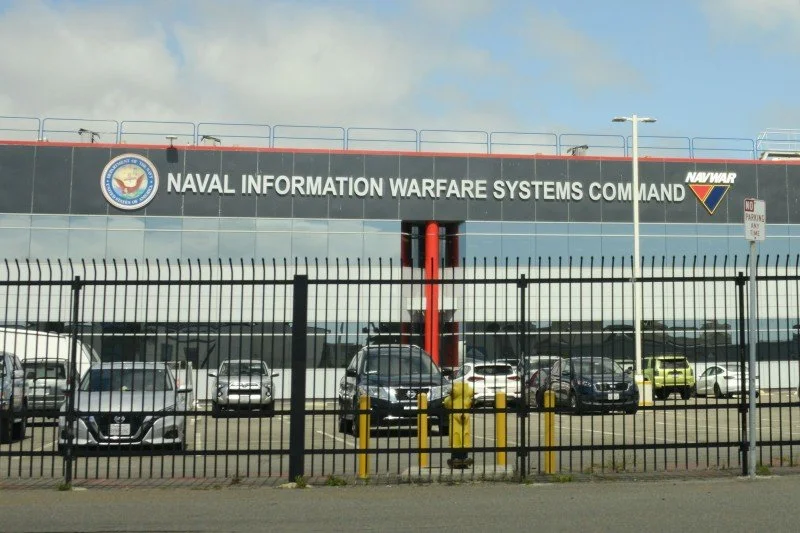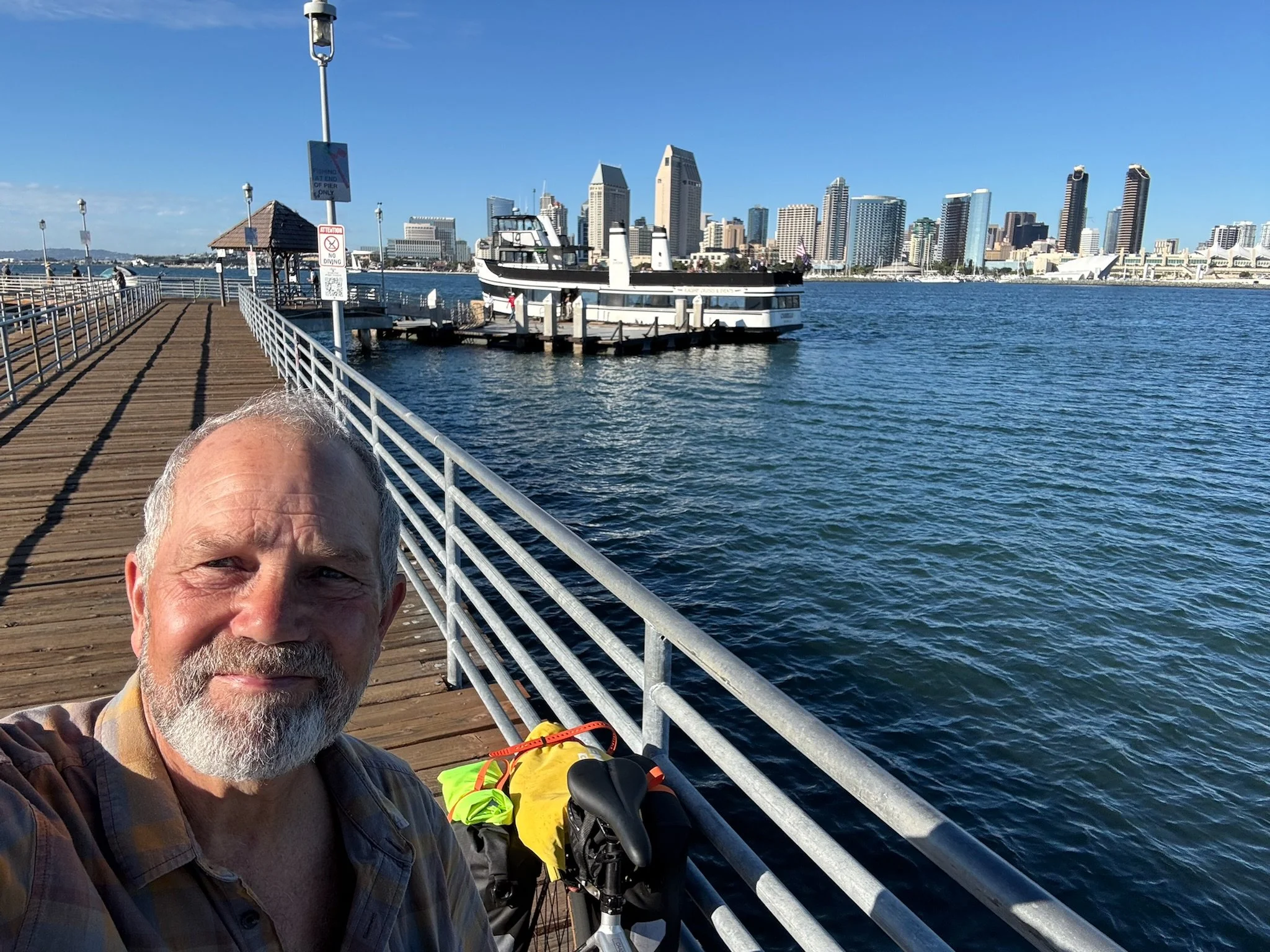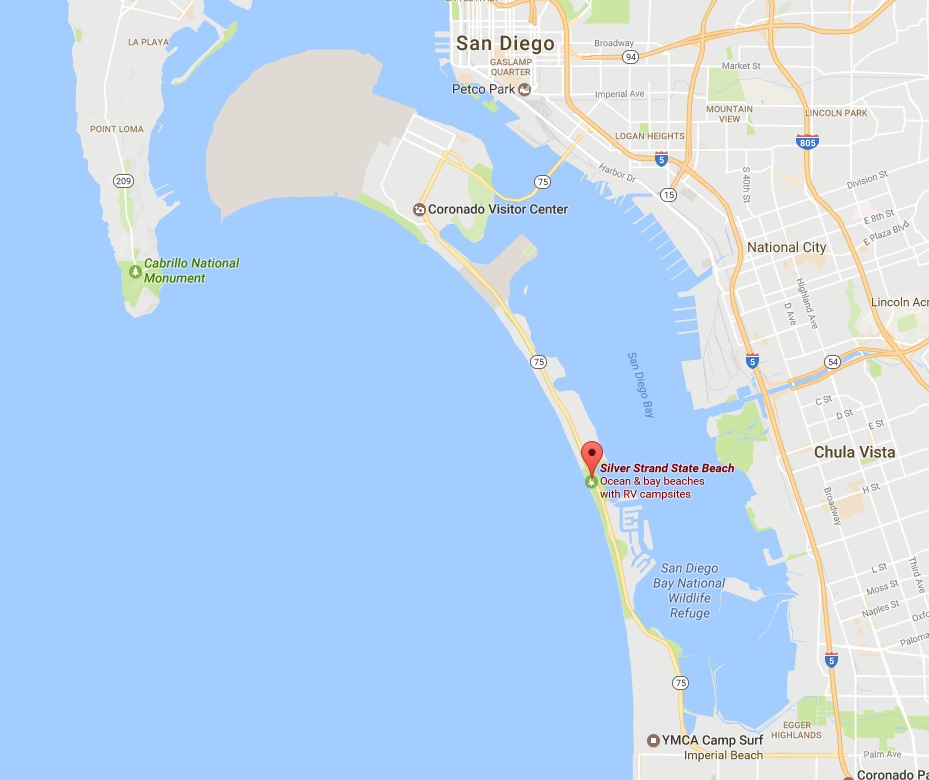Day Thirty-three
San Clemente to Imperial Beach, 75 miles
This was my last full day of riding, having ended close enough to Mexico to enjoy dinner on a restaurant patio in the glow of the city lights of Tijuana. Today’s ride had distinct parts, each very different from the others.
The weather was perfect all day, sunny, 60s-70s, with a quartering tailwind off the ocean. A tailwind directly astern provides no cooling breeze, a still-air bubble that can get very hot. A quartering tailwind gives a nice push, but coming from the side a bit, also cools.
Part One: San Clemente through Camp Pendleton US Marine Corps base
I straddled the bike at 7:48 AM, rode 2 blocks and found the dedicated bike path leading south out of town.
Meet Joe who rides and surfs.
Joe rides to the beach so much that he tricked out his electric-assist, fat-tired (4” wide knobby tires!) bike with a surfboard rack.
Getting to the beach with your board, managing sand and steep hills, is a perfectly legitimate mission for an E-bike, IMHO.
Joe’s 6-year old just started surfing too, so Joe’ll be adding a back seat and maybe a double board rack.
I cycled south along the Avenida Del Presidente, named to honor the road to Nixon’s “Western White House”, and then on to the San Clemente Bike Trail.
At nine miles, I reach the Camp Pendleton “Authorized Personnel Only” sign. It turns out, everyone ignores it, including the Marines. I saw some Marines. They saw me. Very chill.
3 miles later, a sign directed me to the onramp onto I-5, which had a clean, wide, smooth shoulder. At 50 mph, car noise is mostly tires. At 70+ mph, car noise is mostly air whooshing. Faster moving trucks, however, have louder tire noise at high speeds, more of a hum. This makes it easier to know what kind of vehicle is approaching from behind without having to look back.
The world’s nicest rest area
At Oceanside, I rolled off the freeway at the “BICYCLES MUST EXIT” sign and visited this charming rest area.
Part Two: North County Coast
The 20 miles from Oceanside to Torrey Pine is a bike-heaven stretch of riding trails, clear, clean bike lanes, and picturesque towns.
Great food
So many croissants! Everywhere!
Cyclists were everywhere, too!
Various ages, types of bikes and all friendly.
Today more cyclists pulled up next to me and started conversations than have over the previous 32 riding days this entire trip—only four but still!
One rider (I didn’t catch his name) said he plans to organize a ride across America to commemorate the 50th anniversary of the 1976 Bikecentennial. He rode then and he wants to do it again. He is 70 years old.
Map by Bruce Burgess and Dan Burdeno, for the U.S. Department of Transportation - httpntl.bts.govlib250002540025481DOT-HS-803-206.pdf, Public Domain, httpscommons.wikimedia.orgwindex.phpcurid=10501134
Another rider, Bill, explained that we were on historic US 101, which was the main highway between LA and San Diego before I-5 was built in the 1960s. When the freeway came in, these North County Coast towns died, and for years they were known only as surfer-hippy dives.
The towns we see here today have the historical names—Oceanside, Carlsbad, Encinitas, Solana Beach, Del Mar, La Jolla—but are in fact new towns, with roads, infrastructure and commercial centers all modern and up-to-date. And, of course, pricey. These surfer hippies went back to school, started tech companies, made fortunes, and came back with BANK. They are still surfing.
The towns are all served by both the COASTER Commuter Rail Service and the Pacific Surfliner Train. To get around here, all you really need is a rail fare card and one of Joe’s surfer E-bikes.
It’s a retirement haven, but different from any other retirement haven I have ever seen. Demographically retirement communities lean towards the “slowly decomposing”. But here, older people are fit. FIT. Balding, graying, lean, muscled, smiley, chatty, cyclists and surfers.
Part Three: San Diego
Torrey Pines: the south end of the North County Coast
The longest climb of the day was from the beach to the top of the high bluff—where I found not a town but numerous institutions…Scripps Hospital, Scripps Research, the Sauk Institute and UC-San Diego, among others. Even the town of La Jolla felt like an institution—rule-bound, tidy and formal.
And I was in the city, just like that
The approach to San Diego proper was again a dedicated bike path.
A notable thing about San Diego is that the airport is right next to downtown.
Airports are built on principles of large scale efficiency. San Diego seems to be a city built on these same principles. I only had a short time to form this opinion, but from a bike, the whole city has a feel of planned urbanity, not organic, quite…”industrial designed-civic”. I’m making up words here, and I don’t mean this as a criticism, but I just imagine that the city was designed by a team of urban planners with masters degrees, clean sheets and huge budgets.
I initially wrote, “Folded neatly into the fabric of San Diego is the US Navy”, but I think it is the other way around. San Diego is neatly folded into the US Navy.
Can you imagine naming your company the “Naval Information Warfare Warfare Command (NAVWAR)” and plastering that in 10 foot high letters on the side of your building? Oh, and I learned that NAVWAR is part of C4ISR (Command, Control, Communications, Computers, Intelligence, Surveillance and Reconnaissance).
Ferry from San Diego Bay to Coronado
The waterfront is one massive maritime museum. I could spend a week here. The ferry ride across the bay was serene and picturesque at a leisurely 7.5 mph. I know this because my cycling computer was running, so I get a few miles of riding credit for sitting on the ferry.
Part Four: Coronado to Imperial Beach
Coronado has a golf course, a huge grassy park, nice bike lanes, and the famous Hotel de Coronado.
And of course, a massive naval air station. Looking around from this western shoreline of San Diego Bay, again, the navy is everywhere. Aircraft carriers, amphibious assault ships, destroyers. There is always some combination of ships, helicopters, jets, and navy personnel in motion. This isn’t a sleepy navy, it’s an energetic, always striving navy.
Riding south out of the townsite of Coronado, I followed yet another dedicated bike path down the Silver Strand, the north-south sliver of land that separates the mighty Pacific Ocean from lapping San Diego Bay.
At the south end of Silver Strand, facing the ocean, is the Naval Base Coronado Silver Strand Training Complex. As I ended my long, 75-mile day of riding, I saw a squad of navy personnel, in formation on a training run.
The Silver Strand Training Complex, formerly known as the Naval Radio Receiving Facility (NRRF), is now used to train special forces. This facility is known by locals as the "elephant cage"—the nickname of the "Wollan Weber" circular antenna, removed in 2014.
I’m trying to understand why today’s ride was such an easy 75 miles. Partly, I’m stronger and better adjusted to my daily routine of cycling. But I have to say, San Diego County feels so on top of it, so well organized, that the riding just flowed. People here have taken it down a notch from the more frenetic pace of greater LA. San Diego County people, at least the civilian side of the population, are not as driven and ambitious as the folks up in La-La-Land are. They seem more open to each other and to me, and just happier.
I am now just a few miles from “The End”…a 11,600 mile ride I started in 1981.
I’ll ride to the border early tomorrow morning, hover for a few minutes there, try to get someone to take my picture, and begin the process of getting my bike and me home to Montana.
I planned a couple of extra days in case something went awry, but it’s been a smooth, catastrophe-free ride. I now have those days to write an epilogue for the ride. I think I can say it now: I have not had a single flat tire down the entire coast!












